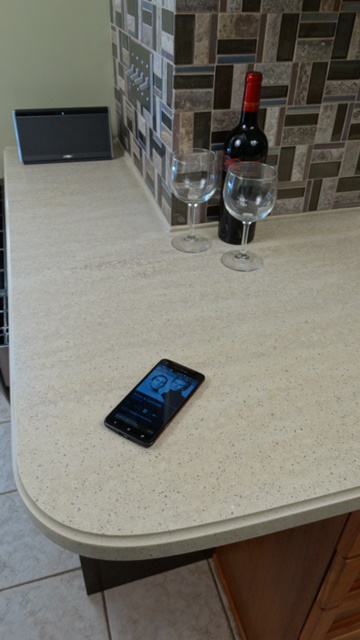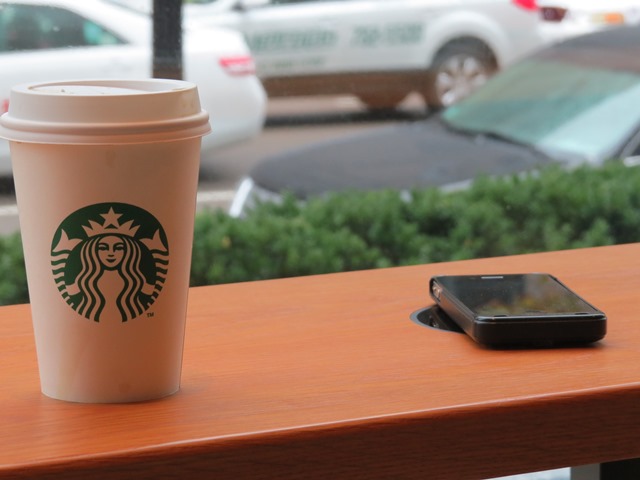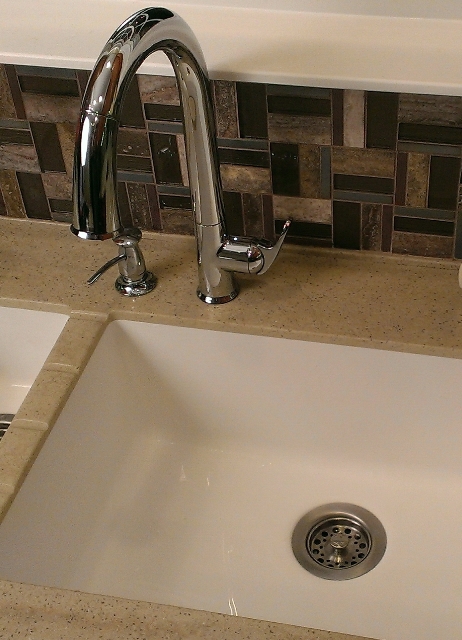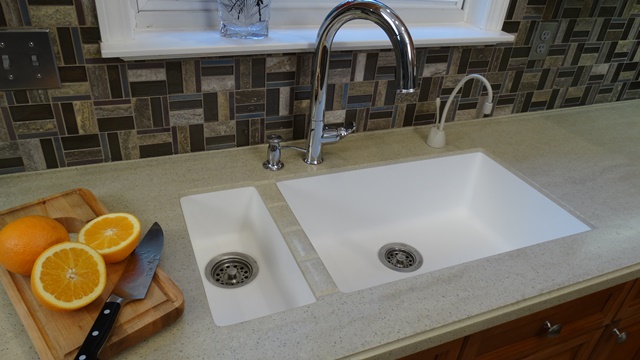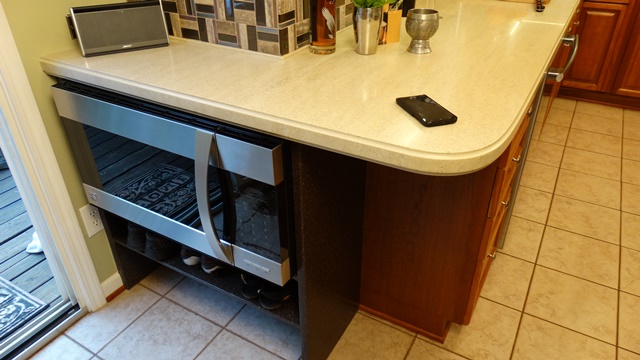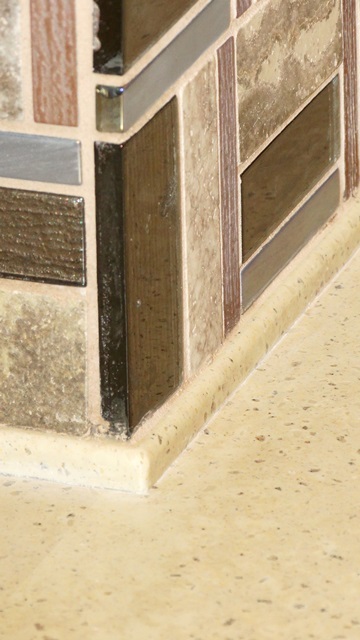Countertops Magazine ArchiveInduction Charging in Smart KitchensSolid Surface with Integral Induction Charging Fits Well with the Evolution of the Kitchen
Technology is growing at an amazing pace, and there are no signs of it slowing down anytime soon. We are looking at a world where nearly everything will be ran by technology in the not-too-distant future. Computers, smartphones and televisions are becoming amazingly advanced, as are most electronics. And with this explosion in technology, our homes are becoming smarter and more connected. The kitchen is no exception. Kitchens are seeing smart refrigerators, ovens, dishwashers and smart appliances in general. Why shouldn’t the countertops our countertops be smart too? The argument can be made that for the past decade granite has been king in the kitchen. With its great look, affordable pricing and perceived durability, granite has been embraced by homeowners and designers alike for its apparent value. Quartz countertops have also come on strong as pricing and patterns have become more affordable and appealing. While there are plenty of positives to be said about both of these surface options, one area where solid surface may have a leg up is in the smart kitchen of the future. The versatility of solid surface has long been well known. Over the past few years, colors and patterns have improved with all of the manufacturing advancements that have come along with the increase in technology. Solid surface sink designs have caught up, and the design capabilities of solid surface are only limited by the imagination. From countertops and cabinets to shelving, and window sills, solid surface can be used to create care free surfaces. However, all that aside, there is one area where solid surface is the clear stand-out: seamlessly integrated induction charging. Built-in Induction Charging The wireless charging industry is in its infancy yet it is estimated to hit $8.5 billion by 2018 with an estimated 50 million units shipped just this year expected to increase to 900 million by 2018, according to Ryan Sanderson, an analyst at IHS Technology. While there are adapters that can be used with a variety of models, phone and tablet manufactures are rapidly adding this feature as standard to their product line-ups (see Figure 1).
Figure 1 – Many smartphones and tablets already include the ability to charge using induction technology, and adapters, such as these for the Duracell Powermat system, are available for many of those that do not yet have the feature. For instance, Starbucks has recently teamed up with Duracell Powermat to begin a national rollout of wireless charging in Starbucks beginning with stores in San Francisco’s Bay Area (see Figure 2). The companies will expand the program to additional major markets in 2015, with a full national rollout in Starbucks company-operated stores planned over time. Initial pilots in Europe and Asia are expected within the year. Stores will be equipped with ‘Powermat Spots’ - designated areas on tables and counters where customers can place their compatible device and charge wirelessly. Select Starbucks stores in Boston and San Jose are already offering the innovation today.
Figure 2 –Starbucks has recently began a national rollout of wireless charging stations in their stores. These stations can be used in nearly any countertop material, as seen here, but only solid surface allows for seamless integral installation. While induction charging can be built-in to any countertop material, what makes solid surface so attractive to this application is that the charger can be embedded seamlessly under the counter top directly below where the phone will be placed to be charged. There is no magic to solid surface when it comes to conductivity. The magnetic charge can pass through approximately 4mm of solid surface to phones or tablets that are built or adapted to receive it. The charge can also pass through most protective cases too. Because the charger remains unseen below the countertop and transmits through the solid surface, the top remains smooth and easy to clean with no place for bacteria or grime to catch as compared to a drop in charger. With the new charging systems, wires are all but forgotten and absent on new countertops. Some of the chargers will even illuminate when charging a phone or tablet, creating a cool look on countertops that are made using a more translucent solid surface material. Some of the solid surface manufacturers like DuPont or LG Hausys have shown display tops with integrated chargers at trade shows or in YouTube videos, but information has been very slow in coming while standards in the industry have been being created. For this reason I spent some time researching how to install my own integral charger. Because integral inductive chargers are not readily available (but will be soon), when taking on this project, I did some research into the options and ended up purchasing a Qi brand charger online. The system was originally designed to be a drop-in model, so I had to remove the outer case before embedding it into the solid surface. During the fabrication of the countertop, I simply routed out a space that the charging unit would fit in, leaving 4mm of countertop material on the surface. This thickness allows a phone, with a protective case, to be charged. I then mounted the charging unit in the hollow space, just tacking it in place with silicone. Once the Qi unit was installed, I just needed a path to a 110-volt receptacle available to power it. In this case, it was located inside the cabinets, which made it all that much easier. One consideration that needs to be taken into account when picking a countertop material that will include an integrated charging unit is that there is a little heat buildup in the top between the phone and the charger when the phone charges. So, non-solid colors may, over the course of time, be smarter color choices. Once a charging system is readily available, it makes many of the other features of a smart kitchen more accessible. Because an easy, hassle-free way to keep a smartphone or tablet charged, homeowners will no longer have to worry about their input device from powering down while they are taking advantage of any number of options. Nearby a Bluetooth speaker system can be streaming music, or a homeowner can be programming his or her various appliances or checking on the temperature of the oven or refrigerator. Heck, with all of the amazing things that can be connected to nowadays, they could be making sure their doors are locked, starting their car to warm up or cool off, checking the dampness of the laundry in their dryer, making sure the lights in the living room are turned off, programming their DVR to record a favorite show, and the list goes on and on…
Figure 3 – In addition to induction charging, touchless faucets such as this Sensa model by Kohler are a standard for the “smart” kitchen. Other Smart Kitchen Features
Figure 4 – These Gemstone 2415-ES and 1507-ES sinks with Opella drain strainers are among many sleek new solid surface sinks with modern designs that can be integrated seamlessly into solid surface countertops, as is done with this top in Mystera Tombolo. Additionally, a smart kitchen will utilize efficiency and maximize space. Because so many jobs are remodels and updates, often cabinets will be refinished to save considerable cost. In our case, it was time to bring the microwave out of the closet (the only space there was for it) and mount it under the countertop. Instead of trying to match existing cabinets, this allowed an opportunity to make a cabinet out of a coordinated solid surface, a great medium for such an application (see Figure 5).
Figure 5 – The versatility of solid surface allows it to be used for such things as this microwave cabinet, as well as shelving and windowsills. And it is virtually maintenance-free. In addition to the cabinet and countertops, solid surface was also the perfect material for our window sills and shelves, adding nice coordinated touches to the kitchen. No longer will I have to repaint the sill and it will always look great. One final detail in my kitchen project involved the backsplash design. While this may not be a “smart kitchen” feature in the technological sense, it certainly was a smart upgrade for my project. From my experience, today’s designers and homeowners want tile backsplashes and the trend has moved away from coved splashes. Some may argue that this denies one of the great features of solid surface and tile does not interface well with solid surface. Mold and mildew penetrating the grout is a negative factor for tile resting on a solid surface top behind the wet areas of the sink. But, nonetheless, I wanted tile in my home. So, to combat this issue, instead of coving a small splash, I used a tile landing (something like a base-shoe on floor moldings) and hard seamed it onto the top (see Figure 6). This can be done after the top is sanded and installed.
Figure 6 – This installation uses a tile landing (something like a base-shoe on floor moldings) hard seamed onto the top as a quick way of ensuring performance behind the faucet, or in any wet area. Tile Landing For this strip, a 1/8-in. radius was applied to the edge of the material, quickly sanded by hand to a polished finish with the 3M sanding sponges to a micro-fine finish and then ripped to 3/8 in. Because the ripped side is used as the seam side, no additional finishing was required, just care. The solid surface top was also pre-sanded, and was installed without having to scribe any of the edges for a tight finish because the tile landing will cover up to 3/8 in. or so of gap that may occur because of walls that are not straight. The lack of scribing greatly speeds up installation. The tile strip was hard seamed on after the top was installed, and because tile was going on the walls, a sheetrock screw was screwed right into the sheet rock carefully to clamp the strip to the deck while the adhesive cured. This allowed room to use a sharp, square chisel to carefully remove the adhesive squeeze out. In this case, I used a 1:1 structural adhesive (SeamBoss) that adheres well to prepolished surfaces without scuffing and cures at a consistent rate so it could easily be cut out while curing, minimizing any effect to the surface finish. When the tile was installed, it was set into a bed of clear silicone and all of the squeeze-out was cleaned with denatured alcohol when wet. Any minor scratches were removed with 3M sanding sponges and one final polish was made to the entire top after since the field seams needed one final sanding. Once finished, the tile landing will buffer any sitting water and dealing with the inevitable water penetration at the joint is no longer necessary. In addition to being extremely practical, the landing also offers nice detail and aesthetics. All in all, for this project solid surface proved to be a very versatile material, and it fits well with the smart kitchens of today. With smartphone and tablet manufactures quickly embracing wireless technology in today’s power-hungry world, smarter surfaces are going to be desired. The next step is for the countertop industry to embrace the possibilities. After all, offering additional features means making additional profits, and that’s just smart business. Editor’s Note: The author would like to thank the late Mike Nolan and his staff for all of their help with this project, which was fabricated in Mike’s shop. Thanks for Charles Monahan for help with the fabrication and Scott Spears for the help with installation. Mike was an inspiration to so many of us in the solid surface community. About the Author Jeff Smith is the sales, marketing and design manager for Gemstone Solid Surface and has been involved in the surfacing industry for more than 17 years. He can be reached at [email protected] or at (574) 294-8899. |

